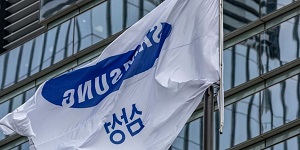The company announced on the 30th that it posted sales of 71.92 trillion won and operating profit of 6.61 trillion won on a consolidated basis in the first quarter of 2024.
Compared to the same period last year, sales increased by 12.8% and operating profit increased by 932.8%.
Regarding the significant increase in operating profit, Samsung Electronics said, “With the information technology (IT) market recovering, memory turned into surplus in response to demand for high-value products, and mobile experience profit ( MX) up also due to strong. famous smartphone sales. ” he explained.
The DS division, which is in charge of semiconductors, recorded sales of 23.14 trillion won and an operating profit of 1.91 trillion won. The DS division continued to suffer losses every quarter from the first quarter to the fourth quarter last year, but they succeeded in turning a profit by making an operating profit for the first time this quarter.
The company explains that overall purchasing demand for memory has been strong due to market expectations for continued price increases, while demand for DDR5 and high capacity solid state drives (SSDs) has been strong since last quarter.
Samsung Electronics explained that it has achieved qualitative growth based on high-value products such as △ High Bandwidth Memory (HBM) △DDR5 △ Server SSD △UFS4.0.
System LSI, which leads non-memory semiconductors, increased its supply of components such as system-on-chip (SoC) and sensors for new products of key customers, but sales of display driver (DDI) chips declined as resulting in slowing down. panel request.
Regarding the foundry (semiconductor load production), Samsung Electronics explained that the development of sales was delayed due to continuous investment changes with major customers, but the deficit was slightly reduced through efficient fab operation.
Samsung Electronics established a 4-nano process product, greatly expanded product production based on key customers, and achieved the highest order receipt record in history in the first quarter by improving the competitiveness of modern processes.
The Device Experience (DX) division, which handles home appliances and mobile devices, won sales of 47.29 trillion and an operating profit of 4.7 trillion.
Samsung Electronics explained that despite negative growth in the smartphone market, sales and operating profit increased due to strong sales of the Galaxy S24 series, the first artificial intelligence (AI) phone.
According to the company, in the TV business, profit increased compared to the previous quarter by focusing on selling high-value products based on strong high demand such as Neo QLED, OLED, and large products 75 -inch and larger.
In terms of the home appliances industry, it was explained that profitability has improved due to an increase in the share of sales of high value home appliances such as major air conditioners and special AI and improvements in cost structure such as material costs.
Harman, which dominates the audio equipment industry, posted sales of 3.2 trillion won and an operating profit of 240 billion won. As we entered the off-season, consumer audio sales slowed, resulting in a slight decrease in performance.
Samsung Display recorded sales of 5.39 trillion won and an operating profit of 340 billion won.
Samsung Electronics said, “In terms of small and medium panels, flexible (flexible displays) responded in good time to the launch of smartphones with major customers, and rigid operation rates (non-bendable displays) improved as a result expanded the sales base, but performance declined compared to the previous quarter due to tightening sales competition “I did it,” he explained.
He said, “In terms of bulk products, market demand had weakened due to off-season arrivals, but the shortfall was reduced by the introduction of new QD-OLED monitors and strengthening the customer base.”
The company spent 11.3 trillion won in resource investment in the first quarter. It amounts to KRW 9.7 trillion in the DS sector and KRW 1.1 trillion in the display sector, an increase of KRW 600 billion compared to the same period last year.
The company explained, “In terms of memory, we continued to invest in research and development (R&D) to strengthen our technological leadership, and in particular focused on investment in resources and post-processing to respond to demand for modern products such as HBM. /DDR5.”
He said, “The refinery continued to invest mainly in infrastructure preparation and state-of-the-art R&D based on medium and long-term demand, and in terms of resource investment, it was run flexibly depending on the situation the market. ”
The company explained that the display sector invested mainly in response to OLED and flexible products for IT. Reporter Baram Kim
2024-04-30 00:33:44
#Samsung #Electronics #operating #profit #quarter #KRW #trillion #semiconductors #turned #profit #KRW #trillion


